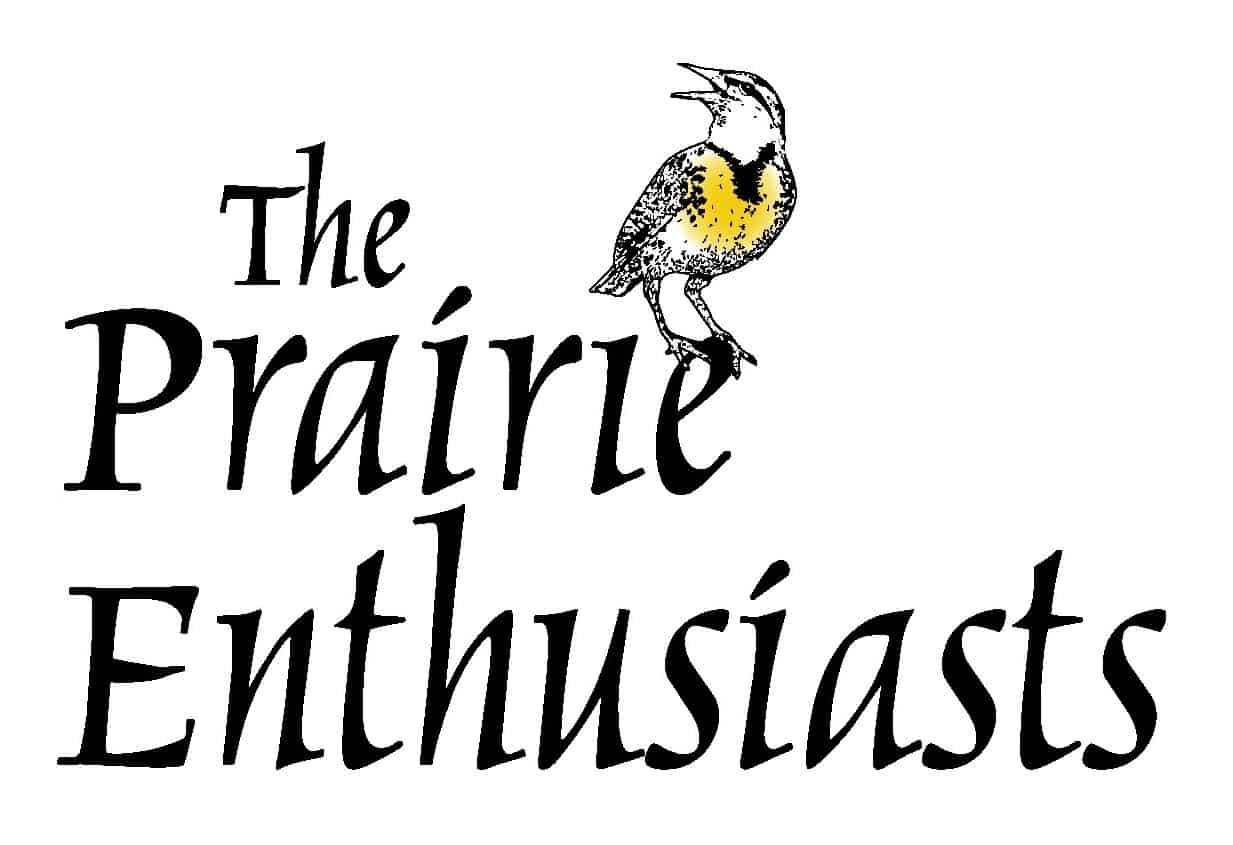
by The Prairie Enthusiasts | Sep 4, 2019 | News
By Jim Vonderharr
Many Rivers Chapter has recently started partnerships with several educational entities. We were contacted in the spring of 2017 by Amber Gremmels, a middle school science teacher in New Ulm, Minn. The New Ulm School District has two vacant residential lots next to it that were just being mowed. She envisioned converting one of them to a prairie, and making it a learning experience for students.
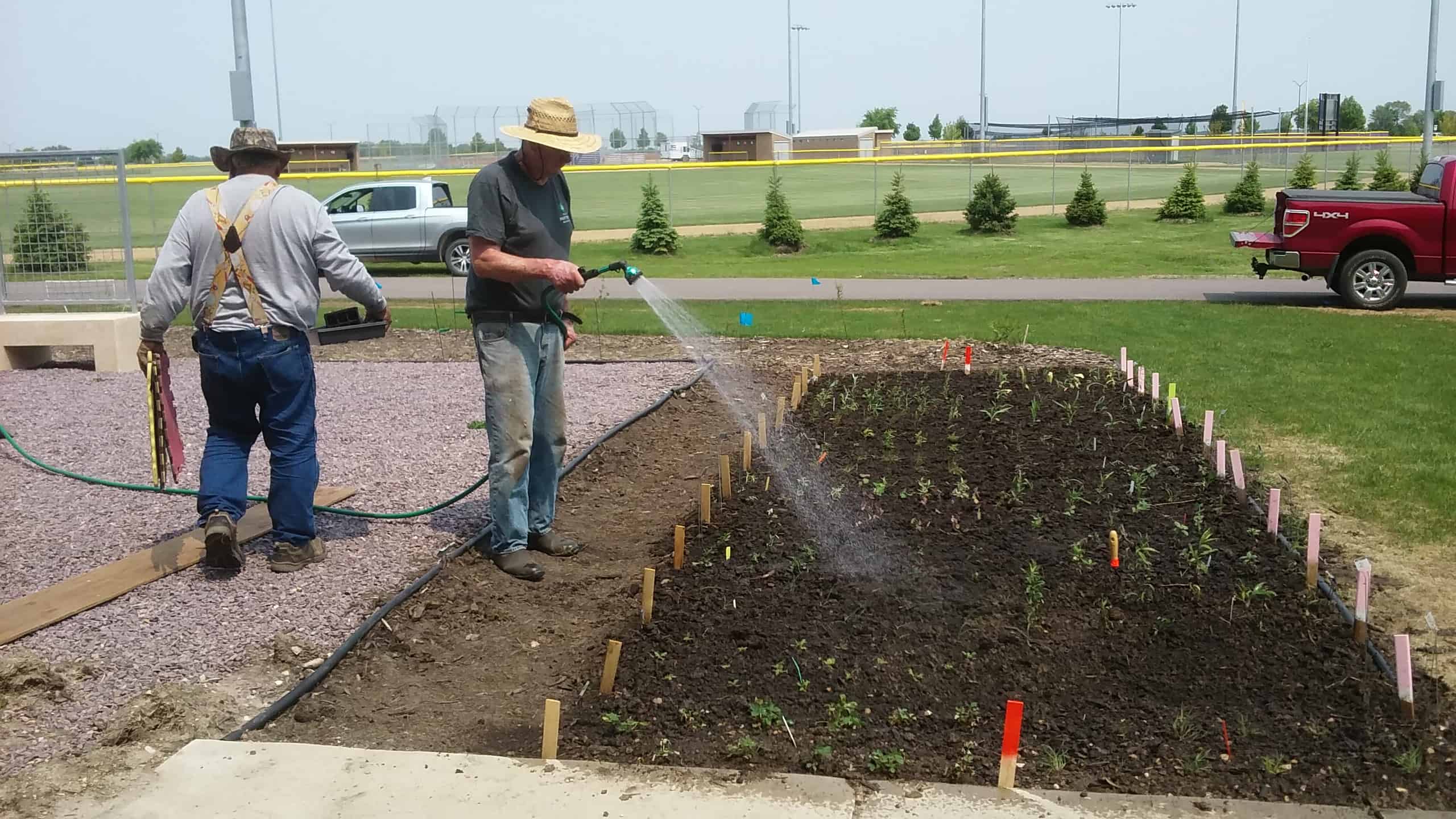 Gremmels was looking for help. Our chapter worked with her, and over that summer we coordinated the clearing (Roundup) of about ¾ of one of the lots. That fall, fellow chapter member Henry Panowitsch and I broadcast seeded the plot with a mix of grasses and forbs. As expected, 2018 produced a typical first-year prairie project – a not-so-beautiful prairie. There were signs of desired plants, however, and this spring (2019) we mowed it. We are anxious to see what comes up and mow again throughout the growing season. We may add some seedlings or transplants.
Gremmels was looking for help. Our chapter worked with her, and over that summer we coordinated the clearing (Roundup) of about ¾ of one of the lots. That fall, fellow chapter member Henry Panowitsch and I broadcast seeded the plot with a mix of grasses and forbs. As expected, 2018 produced a typical first-year prairie project – a not-so-beautiful prairie. There were signs of desired plants, however, and this spring (2019) we mowed it. We are anxious to see what comes up and mow again throughout the growing season. We may add some seedlings or transplants.
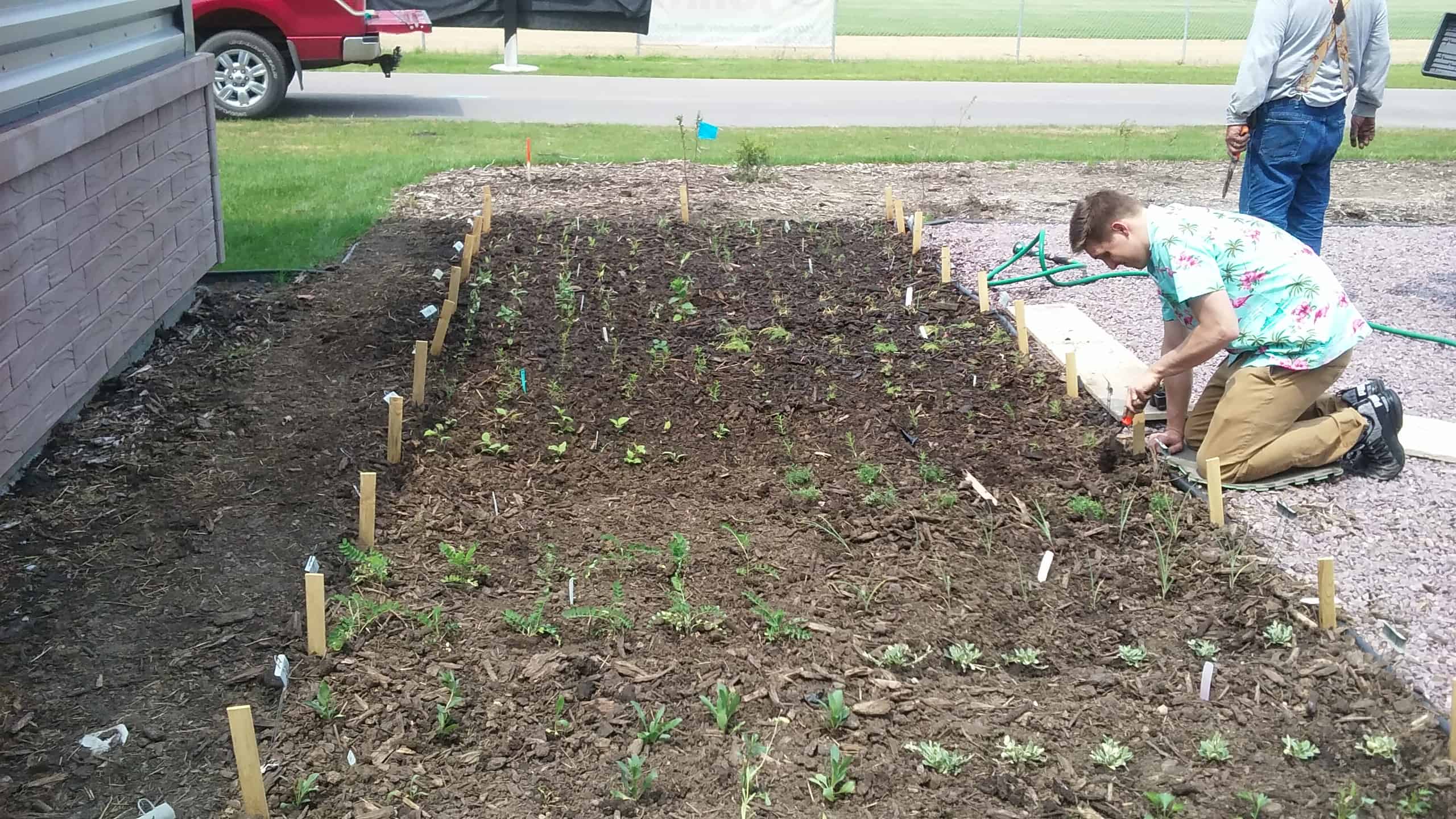
To allay concerns that the lot was just a neglected “weed patch,” a sign was posted announcing our intended results.
In the fall of 2018, we were contacted by Matt Nelson, a high school science teacher in New Ulm. The school is relatively new (maybe 3 years old) and outside of his classroom is a space designed to be an “outdoor classroom.” Matt wants to make it a prairie education tool. It consists of sections, a couple covered with rock and benches, and several with wood chips.
Once again, Panowitsch and I, accompanied by Jim Lynch, ventured to New Ulm and visited with Nelson. The three of us made an impromptu presentation to his students, and we then discussed options for the project. This time we decided to use a majority of the area for plant identification, which meant buying established seedlings. Because of the cost associated with this plan, we contacted the New Ulm Chapter of the Izaac Walton League for assistance. They have funds from charitable gambling available for investment in their community. They enthusiastically volunteered to support the project and have contributed $1,000.
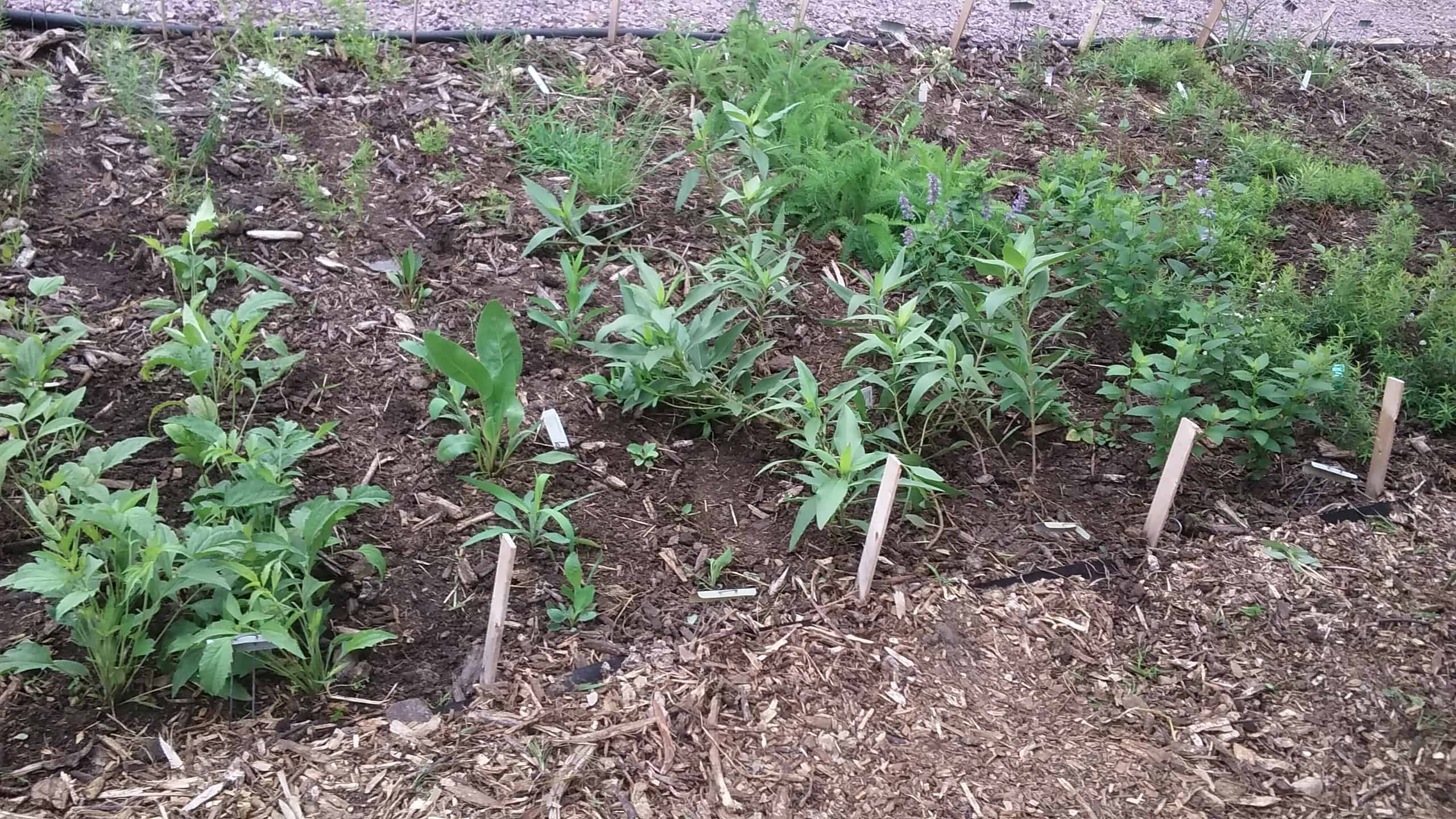
We also hope to help Nelson develop and stock a library with prairie resource materials. Buoyed by enthusiasm for these two projects, we have recently joined a group at Minnesota (Mankato) State University (MSU) that is working on a teaching curriculum that will include prairie education. Julia Batten, a Mankato East High School teacher is a member of the MSU curriculum team. We are hoping for the prairie “bug” to infect Mankato schools soon.
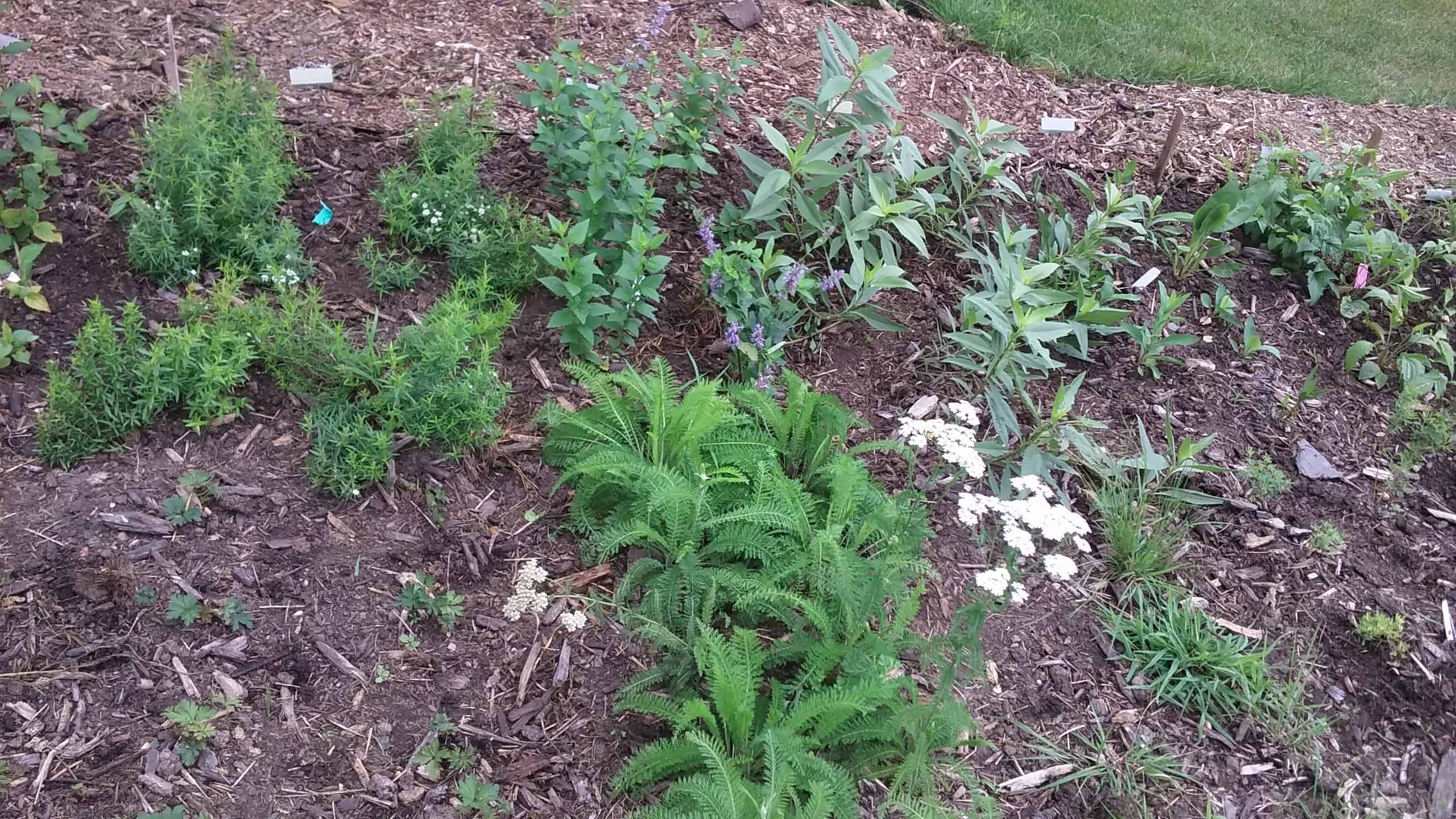
Photos by Jim Lynch

by The Prairie Enthusiasts | Jul 31, 2019 | Inspiration
This introduction to the concept of resilience and how it applies to our prairie restoration work was an article published in the August 2019 Prairie Promoter.
Those of us who were at this year’s TPE conference in Menomonie were introduced to resilience during the keynote address. As a review, resilience is simply the ease at which a disturbance can move a system from one state to another. For us prairie enthusiasts looking to apply these concepts to prairie management, disturbances might be such things as fires or intense woody species removal through herbicide use or grazing by goats. General states might include functioning prairies/savannas, degraded prairies/savannas, and reconstructed prairies, fallow fields or cropland.
As most of us know all too well, shifting from some of these states to another can be difficult, and thus, those states are considered resilient. Note that resilience is not a judgment on quality, but rather just the ability to be changed from one state to another. Also, the shift from one state to another can be rapid (such as plowing a prairie to convert to cropland) or slow (such as absence of disturbance leads to a degraded prairie.) Furthermore, a state can change somewhat without moving to a new state.
Let’s apply the principles of resilience to restoring degraded prairies/savannas. Unfortunately, degraded systems are often resilient! The degraded state of a prairie/savanna could be a result of changes in fire frequency, grazing (too much or too little), climate or other drivers, or combinations of these. Reversing one or more of these drivers does NOT rapidly convert a degraded remnant back to a fully functioning remnant.
Degraded systems usually become degraded through a slow process, and one might expect a shift back to a functioning prairie/savanna state might also be a slow process. A degraded prairie is often degraded because of invading woody species. Using the example of prescribed burning as the disturbance, a fire will not rapidly kill all the woody growth and cause a shift from a degraded state back to a functioning prairie/savanna. In fact, short-term effects of reintroduction of fire might have some undesirable effects such as increased number of stems of clonal species and re-sprouts from most species.
We find similar slow results when applying a quick removal of woody species using herbicides or grazing on a degraded site. The rapid removal of the canopy results in invasions by some opportunistic species. We know these species all too well – sunflowers, brambles and short-lived species. It may take decades for these species to come back into some kind of balance with less aggressive species. Even removed shrubs and trees can return either through resprouting or from a well-established seed bank.
The stability of a state can be influenced by non-native species. These species don’t play by the rules that were established as our prairie/savanna ecosystems were evolving, as insect and disease controls for these species are absent in their new environment. Non-natives therefore have an advantage when invading areas with disturbance. The fact that the invasive non-natives have become so ubiquitous across the landscape further makes a degraded system more resilient and our quality remnants less resilient.
Another consideration at the landscape scale is fragmentation. Fragmentation, the isolation of similar natural communities, can’t be ignored when considering the state of individual remnants. In terms of resilience, the isolation may have altered the state through the loss of healthy genetics or complete loss of some species. This idea leads to our cautious use of disturbance during management that may result in species loss that can’t be undone easily given the lack of proximity of sources for the species potentially lost. Our remnants are less resilient due to this fragmentation.
So where does all of this leave us when considering the effects of management on degraded prairies? Prairie restorationists are probably more patient than the average person, but our expectations are probably still too high. Some might consider the solution to be a heavy dose of frequent fire, herbicides or grazing. However, quick results are unlikely given the resilience of degraded systems, and things may get worse before we finally shift a degraded system back to the state of a functioning prairie/savanna.
Hopefully the rudimentary discussion on resilience provided here serves to keep our minds open to this topic when considering our management practices. Be patient and expect frustrations as we undertake the challenge of altering an undesirable resilient state to a healthy prairie or savanna.

by The Prairie Enthusiasts | Jul 31, 2019 | News
This summer marks my seventh year with TPE and completes our 50th land protection project. One of the special responsibilities that comes along with completing all these projects is the care we give these sites by burning, brushing and planting more prairies and savannas. Now that TPE is accredited, one additional activity we must do is complete an annual visit to all our conservation easements and fee-owned properties to complete a monitoring report. We now need volunteers to help with the monitoring.
 Besides documenting the results of our management, and protecting the land use on the conservation easements, doing these visits gives us a chance to see firsthand the amazing places TPE’s chapters have protected throughout the years. Most of these visits are done in the late fall, and consist of walking the property boundaries and taking landscape photos at certain points and corners. Once done with the visit, a written report with photos and a corresponding map are kept on file.
Besides documenting the results of our management, and protecting the land use on the conservation easements, doing these visits gives us a chance to see firsthand the amazing places TPE’s chapters have protected throughout the years. Most of these visits are done in the late fall, and consist of walking the property boundaries and taking landscape photos at certain points and corners. Once done with the visit, a written report with photos and a corresponding map are kept on file.
Last year, TPE invested in a software platform called Landscape (www.landconservationsoftware.com), owned by Caleb Pourchot of Madison, Wis., who created the software program while working for Groundswell Conservancy. This new cloud-based software enables monitors to use a smartphone to take pictures, use the GPS to mark its location, and load everything into the software program on line. Things have come a long way since I was taking 35mm film photos for the first conservation easement baseline back in 2003. Now I can walk the property with my cell phone, take the pictures and fill the report out with my computer back at my desk, and save it all electronically.
 In 2018, TPE added seven new sites that will need to be monitored this fall. We have had a dedicated but small group of conservation easement monitors for the past several years, and most of our site stewards also have completed an annual monitoring report. With our growing land protection program, we need to find additional volunteers to help.
In 2018, TPE added seven new sites that will need to be monitored this fall. We have had a dedicated but small group of conservation easement monitors for the past several years, and most of our site stewards also have completed an annual monitoring report. With our growing land protection program, we need to find additional volunteers to help.
I’ll be hosting an on-line Property Monitoring Training Program at 7 p.m. Sept. 18, with the goal of training new volunteers to help TPE and its chapters continue to monitor our protected lands. If you enjoy taking hikes on TPE’s sites, can navigate a property using a map, and are interested in using the technology of your smartphone to help TPE in carry out its mission, please consider an RSVP to TPE’s Property Monitoring Training. You can reach me at 608-638-1873 or executivedirector@theprairieenthusiasts.org, and I can help get you out on the prairie!

by The Prairie Enthusiasts | Dec 5, 2018 | News
Our work helping to restore Moely Prairie, a 23.5-acre remnant sand prairie on the outskirts of Prairie du Sac, has been one big exercise in repaying some of the attention I owe to wild places and beings. Here is my story of paying down the staggering debt.
 It was a sun-splashed July day. As my wife Amy and I wandered around the prairie, I scanned the ground for the new and the novel. Even when I was forced to stop and really pay attention, as when Amy settled into a patch of blooming wild bergamot (Monarda fistulosa) to photograph butterflies and bees, I looked more than I saw. I worked the ground over. Although it was a pleasant enough visit, I left feeling a little disappointed that we did not find any undocumented plant species that afternoon, as we had on so many other days.
It was a sun-splashed July day. As my wife Amy and I wandered around the prairie, I scanned the ground for the new and the novel. Even when I was forced to stop and really pay attention, as when Amy settled into a patch of blooming wild bergamot (Monarda fistulosa) to photograph butterflies and bees, I looked more than I saw. I worked the ground over. Although it was a pleasant enough visit, I left feeling a little disappointed that we did not find any undocumented plant species that afternoon, as we had on so many other days.
I’m one of those list people; I’d be lost without my daily and weekly to-do lists. I particularly love the plant list, or inventory, that we inherited from former Site Steward Sue Kenney, and I’ve often rhapsodized in my journal about the species we have been fortunate to add to it. Here’s how bad it is: I even keep a list of rare plants that I someday hope to find on this prairie, like prairie fame-flower (Phemeranthus rugospermus) and wooly milkweed (Asclepias lanuginosa), however unlikely it may be that they ever grew here.
But the words the universe threw in front of me later that July day were these: “We speak of ‘paying attention’ because of a correct perception that attention is owed — that without our attention and attending, our subjects, including ourselves, are endangered.” Wendell Berry’s insights have given me great solace through the years, but this time I felt more convicted than comforted. Far too often, I have become a slave to my lists and failed to savor the species we identify and document, or appreciate their importance to each other and the prairie as a whole.
By and large, however, our work helping to restore Moely Prairie, a 23.5-acre remnant sand prairie on the outskirts of Prairie du Sac, has been one big exercise in repaying some of the attention I owe to wild places and beings. Fortunately, the amount of restoration work yet to be done on Moely will give me years to pay down my staggering debt.
Fits and starts
 I first stepped onto Moely Prairie in 2010, when it looked very little like a prairie. About the only thing visible besides red cedar, cherry, black oak and honeysuckle was the ginormous stars & stripes fluttering over Mueller Sports Medicine across Highway PF. I was there to listen to a presentation sponsored by the Sauk Prairie Conservation Alliance (SPCA), which, along with the Aldo Leopold Foundation, was helping to manage the property for landowner Barbara Moely. Barbara wished to see the property that her family has owned since the 1800s, and its unique natural plant communities, protected in perpetuity, so she placed a conservation easement on the parcel.
I first stepped onto Moely Prairie in 2010, when it looked very little like a prairie. About the only thing visible besides red cedar, cherry, black oak and honeysuckle was the ginormous stars & stripes fluttering over Mueller Sports Medicine across Highway PF. I was there to listen to a presentation sponsored by the Sauk Prairie Conservation Alliance (SPCA), which, along with the Aldo Leopold Foundation, was helping to manage the property for landowner Barbara Moely. Barbara wished to see the property that her family has owned since the 1800s, and its unique natural plant communities, protected in perpetuity, so she placed a conservation easement on the parcel.
A few months later, in subzero temps, I helped SPCA volunteers pile and burn cut cedar and honeysuckle at Moely. Although I would go on to help clear invasive species at Hillside Prairie—another, smaller, remnant of the original 14,000-acre Sauk Prairie located in what is now the Sauk Prairie State Recreation Area—I would not work on Moely again until 2016.
By then I’d met and fallen in love with Amy, who after about a year, and without too much coercion on my part, consented to marry me. Amy’s parents later moved to Prairie du Sac, too, and as it happened, the house they bought bordered Moely Prairie. Amy’s dad, Paul Anderson, grew up on a farm in Iowa. Now retired, he was eager to see what he could do to help restore the prairie in his backyard. “For years,” he likes to tell visitors now, “I plowed prairie; now I get to restore it.”
Restoration efforts at Moely had stalled by 2016, but I was able to put Paul in touch with Charlie Luthin, SPCA’s director. The Prairie Enthusiasts had recently assumed management responsibility for Moely, we learned, but Charlie made introductions for us. Soon Paul, Amy and I were cutting and spraying invasives under the experienced eye of Denny Connor, TPE’s new site steward for Moely, and Walking Iron, Prairies. By last fall, we had cleared enough trees and shrubs off the east end of Moely to conduct our first prescribed burn.
 When Amy retired from the Madison Police Department early this year, she began devoting dozens of hours per week to Moely. Her enthusiasm and organizational savvy, in particular, helped build up a small but dedicated cadre of other volunteers. Soon Moely had its own Facebook page, Instagram account, eye-catching brochure, and twice-weekly as well as monthly weekend work parties. This past summer, Paul convinced a friend of his to bring his drone out to Moely to capture some aerial stills and video of the prairie, which will help us document and prioritize restoration efforts. As if we doubted it, the photos reinforced the enormity of our task. It is hard to imagine a day when we will not refer to the southwestern third of Moely as “The Jungle” (although a Landowner Incentive Program grant Denny won for us this fall will help us make a substantial dent in it).
When Amy retired from the Madison Police Department early this year, she began devoting dozens of hours per week to Moely. Her enthusiasm and organizational savvy, in particular, helped build up a small but dedicated cadre of other volunteers. Soon Moely had its own Facebook page, Instagram account, eye-catching brochure, and twice-weekly as well as monthly weekend work parties. This past summer, Paul convinced a friend of his to bring his drone out to Moely to capture some aerial stills and video of the prairie, which will help us document and prioritize restoration efforts. As if we doubted it, the photos reinforced the enormity of our task. It is hard to imagine a day when we will not refer to the southwestern third of Moely as “The Jungle” (although a Landowner Incentive Program grant Denny won for us this fall will help us make a substantial dent in it).
Education and resurrection
As almost anyone who does ecological restoration knows, it’s as rewarding as it is exhausting. And habit forming. Like many novices, I marveled at Moely’s botanical riches, especially the showier examples: eastern prickly-pear cactus (Opuntia humifusa), prairie-smoke (Geum triflorem), and lead-plant (Amorpha canescens). Marvel quickly morphed into a yearning to learn (and yes, find and document) more. When one day I spotted a few tiny, delicate, blue-blossomed plants ringed by honeysuckle, I did a quick Internet search. It wasn’t long before I’d confirmed that what I’d found was prairie blue-eyed grass (Sisyrinchium campestre), a native plant not on the official inventory.
Thrilled by this apparent resurrection, and Paul’s subsequent discovery of a few American pasque-flowers (Anemone, patens) plants on Moely in March of 2017, I became obsessed with finding more. With the help of a wonderful citizen science app Amy discovered called iNaturalist, and books like Wildflowers of Wisconsin and the Great Lakes Region, we have identified dozens more native plant species never before documented on Moely, including slender nut sedge (Cyperus lupulinus), Cleland’s evening-primrose (Oenothera clelandii), purple prairie clover (Dalea pupurea), wild bergamot (Monarda fistulosa) and smooth blue aster (Symphyotrichum laeve). [Some of these discoveries await confirmation by TPE’s own team of experts before being added to the official plant inventory.]
 When she wasn’t organizing work parties, or broadcasting the wonders of Moely Prairie on social media, Amy was immersing herself in the diverse insect life of Moely. She attended a workshop at the UW Arboretum on how to identify and photograph bees, and signed us up for training to become monarch butterfly monitors with Monarch Joint Venture (MJV). Now official citizen scientists, we monitor a hectare-sized plot on Moely, counting milkweed (Moely has 3 species) and other flowering plants useful to monarchs, and then upload our findings to MJV’s central database. With the help of experts at wisconsinbutterflies.org, Amy also added several new butterfly species to Moely’s Lepidoptera inventory, including “summer” spring azure (Celastrina ladon neglecta) and juniper hairstreak (Callophrys gryneus), the only green butterfly in Wisconsin.
When she wasn’t organizing work parties, or broadcasting the wonders of Moely Prairie on social media, Amy was immersing herself in the diverse insect life of Moely. She attended a workshop at the UW Arboretum on how to identify and photograph bees, and signed us up for training to become monarch butterfly monitors with Monarch Joint Venture (MJV). Now official citizen scientists, we monitor a hectare-sized plot on Moely, counting milkweed (Moely has 3 species) and other flowering plants useful to monarchs, and then upload our findings to MJV’s central database. With the help of experts at wisconsinbutterflies.org, Amy also added several new butterfly species to Moely’s Lepidoptera inventory, including “summer” spring azure (Celastrina ladon neglecta) and juniper hairstreak (Callophrys gryneus), the only green butterfly in Wisconsin.
Although the buzzing song of the clay-colored sparrow (Spizella pallida) had already returned to Moely before we picked up the loppers from our restoration predecessors, it was a joy for us to hear it there for the first time last spring. And it heralded the potential for more, winged resurrections. Eastern and western meadowlarks might also return to Moely someday, as forbs and grasses regain their rightful place on this unique prairie remnant that has never felt the cut of a plow.
What gives us the most hope, though, is the return of adolescent Homo sapiens to Moely Prairie.
 Since Paul reached out to science teacher Patrick Leigh at Sauk Prairie High School and Patrick invited us to present to several of his classes in October, almost all of those students have toured Moely. A few have joined us for work days. One enthusiastic young man is even making Moely central to his National Honor Society project.
Since Paul reached out to science teacher Patrick Leigh at Sauk Prairie High School and Patrick invited us to present to several of his classes in October, almost all of those students have toured Moely. A few have joined us for work days. One enthusiastic young man is even making Moely central to his National Honor Society project.
The overriding management goal for Moely is “to recover as much of the site’s original prairie, as is feasible, for the benefit of current and future generations so they may experience, enjoy and learn from such natural areas and the plants and animals found there.” We won’t do that by simply lengthening our lists, or crossing things off them. No, we and future generations will need to continue to give to places like Moely, and its diverse flora and fauna, our concentrated “attention and attending.” Otherwise, as Wendell Berry cautions, not only will they be endangered, we will be, too.

by The Prairie Enthusiasts | Sep 6, 2018 | News
On August 30th, The Prairie Enthusiasts achieved a long term goal of both TPE and The Nature Conservancy – the acquisition and permanent protection of two prairie remnants of distinction owned by Paul and Judy Swenson of Arena, WI.
 Situated in the lower Mill Creek valley and along County Highway H south of Arena, in Iowa County, WI, the two remnants are part of a larger collection of much-studied natural areas. The sites have gone by various names; the St. John’s Complex (named after the nearby Catholic Church), Swenson Hill Prairie (the larger of the two) and Shooting Star Prairie, which is shared by a neighbor. The remnants have been the focus of protection efforts since the early 1990’s when TNC was the lead and TPE was still a small organization. At least one site within the larger complex was part of John Curtis’s inventory of natural areas in the 1950’s.
Situated in the lower Mill Creek valley and along County Highway H south of Arena, in Iowa County, WI, the two remnants are part of a larger collection of much-studied natural areas. The sites have gone by various names; the St. John’s Complex (named after the nearby Catholic Church), Swenson Hill Prairie (the larger of the two) and Shooting Star Prairie, which is shared by a neighbor. The remnants have been the focus of protection efforts since the early 1990’s when TNC was the lead and TPE was still a small organization. At least one site within the larger complex was part of John Curtis’s inventory of natural areas in the 1950’s.
 The remnants have a high and evenly-distributed diversity of classic dry prairie plants. In spring there is a flush of ephemeral plants like yellow-star grass and violet wood sorrel, and in mid-summer, a huge show of leadplant, prairie coreopsis and butterfly weed. Among the rarer plants found on the two sites are Hill’s thistle and pomme-de-prairie (Psoralea esculenta). The sites are also known for harboring rare insects, especially the State Endangered leafhopper Attenuipyga vanduzeei.
The remnants have a high and evenly-distributed diversity of classic dry prairie plants. In spring there is a flush of ephemeral plants like yellow-star grass and violet wood sorrel, and in mid-summer, a huge show of leadplant, prairie coreopsis and butterfly weed. Among the rarer plants found on the two sites are Hill’s thistle and pomme-de-prairie (Psoralea esculenta). The sites are also known for harboring rare insects, especially the State Endangered leafhopper Attenuipyga vanduzeei.
TPE has been active on these sites since 2002 when US Fish and Wildlife Service funding helped clear both sites of encroaching brush, especially eastern red cedar. At least four TPE field trips have visited the sites since then. Volunteer crews have applied infrequent fire to the larger of the two remnants to control returning brush, but there is still much work to be done. Now that TPE owns the prairies in fee title, the stewardship work can pick up pace once again.
 Funding for this acquisition was made possible by the Wisconsin Department of Natural Resources Knowles-Nelson Stewardship Program. TPE Executive Director Chis Kirkpatrick coordinated the deal and made sure all the pieces were in their proper place.
Funding for this acquisition was made possible by the Wisconsin Department of Natural Resources Knowles-Nelson Stewardship Program. TPE Executive Director Chis Kirkpatrick coordinated the deal and made sure all the pieces were in their proper place.
Special thanks go to Paul and Judy Swenson, who have always shown an interest in the natural areas of their dairy farm, for allowing TPE access over the years, and for patience in the acquisition process. A big thank you also goes to Amy Staffen, as she worked with me in maintaining ties with the Swensons through the past decades, thus keeping the project alive.

 Gremmels was looking for help. Our chapter worked with her, and over that summer we coordinated the clearing (Roundup) of about ¾ of one of the lots. That fall, fellow chapter member Henry Panowitsch and I broadcast seeded the plot with a mix of grasses and forbs. As expected, 2018 produced a typical first-year prairie project – a not-so-beautiful prairie. There were signs of desired plants, however, and this spring (2019) we mowed it. We are anxious to see what comes up and mow again throughout the growing season. We may add some seedlings or transplants.
Gremmels was looking for help. Our chapter worked with her, and over that summer we coordinated the clearing (Roundup) of about ¾ of one of the lots. That fall, fellow chapter member Henry Panowitsch and I broadcast seeded the plot with a mix of grasses and forbs. As expected, 2018 produced a typical first-year prairie project – a not-so-beautiful prairie. There were signs of desired plants, however, and this spring (2019) we mowed it. We are anxious to see what comes up and mow again throughout the growing season. We may add some seedlings or transplants.


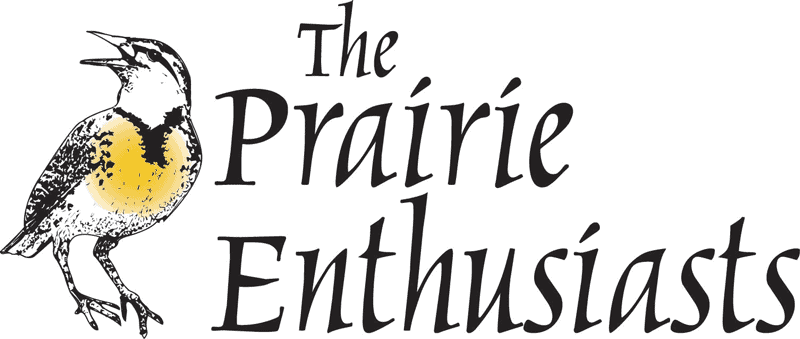
 In 2018, TPE added seven new sites that will need to be monitored this fall. We have had a dedicated but small group of conservation easement monitors for the past several years, and most of our site stewards also have completed an annual monitoring report. With our growing land protection program, we need to find additional volunteers to help.
In 2018, TPE added seven new sites that will need to be monitored this fall. We have had a dedicated but small group of conservation easement monitors for the past several years, and most of our site stewards also have completed an annual monitoring report. With our growing land protection program, we need to find additional volunteers to help. It was a sun-splashed July day. As my wife Amy and I wandered around the prairie, I scanned the ground for the new and the novel. Even when I was forced to stop and really pay attention, as when Amy settled into a patch of blooming wild bergamot (
It was a sun-splashed July day. As my wife Amy and I wandered around the prairie, I scanned the ground for the new and the novel. Even when I was forced to stop and really pay attention, as when Amy settled into a patch of blooming wild bergamot (



 Situated in the lower Mill Creek valley and along County Highway H south of Arena, in Iowa County, WI, the two remnants are part of a larger collection of much-studied natural areas. The sites have gone by various names; the St. John’s Complex (named after the nearby Catholic Church), Swenson Hill Prairie (the larger of the two) and Shooting Star Prairie, which is shared by a neighbor. The remnants have been the focus of protection efforts since the early 1990’s when TNC was the lead and TPE was still a small organization. At least one site within the larger complex was part of John Curtis’s inventory of natural areas in the 1950’s.
Situated in the lower Mill Creek valley and along County Highway H south of Arena, in Iowa County, WI, the two remnants are part of a larger collection of much-studied natural areas. The sites have gone by various names; the St. John’s Complex (named after the nearby Catholic Church), Swenson Hill Prairie (the larger of the two) and Shooting Star Prairie, which is shared by a neighbor. The remnants have been the focus of protection efforts since the early 1990’s when TNC was the lead and TPE was still a small organization. At least one site within the larger complex was part of John Curtis’s inventory of natural areas in the 1950’s.
